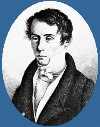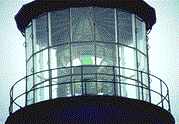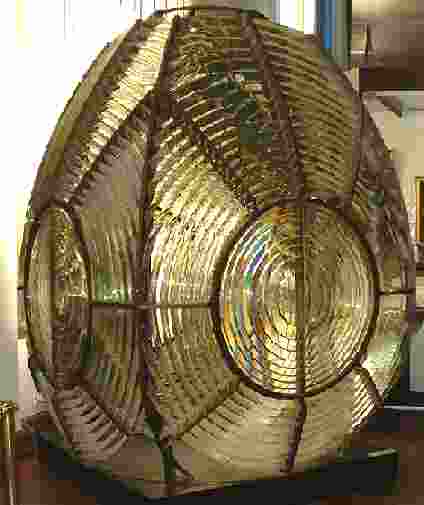|
The
earliest lighthouses were simply bonfires built on
hilltops to guide ships. The light from a bonfire
could not have been very bright or traveled vary far.
No doubt it was better than no light at all, but things
were to improve, once the Admiralty became convinced of
the safety value.

Augustine
Fresnel
Then in 1822 a French Physicist named Augustine Fresnel
invented a lens that would make his name commonplace
along the coasts of Europe and North America. A fresnel
lens looks like a giant glass beehive, with a light at the
center. The lens could be (and usually is) as tall as twelve feet, with
concentric rings of glass prisms above and below to bend
the light into a narrow beam. At the center the lens was
shaped like a magnifying glass, so the concentrated beam
was even more powerful. Tests showed that while an open
flame lost nearly 97% of its light, and a flame with
reflectors behind it still lost 83% of its light, the
fresnel lens was able to capture all but 17% of its
light. Because of its amazing efficiency, a fresnel lens
could easily throw its light 20 or more miles to the
horizon. Because of the improved range, it became
necessary to build taller light houses to enable the
full range to be achieved - hence overcome the curvature
of the earth.

Rhode
island - non flashing fresnel lens
The above is an example of a plain first-order
(non-flashing) lens. This one has an unusual green
color. This lens still operates at the Southeast
Light on Block Island, Rhode Island, USA.
Orders of lenses were
developed. There were seven types, the first three orders
and largest were for
seacoast lights, while orders four through six were
smaller, for harbor or bay lights. There was also a 3.5
order lens which was used mostly in the Great Lakes,
USA.. In Europe the new lenses were adopted more
quickly, but the
head of the U.S. Lighthouse Board, Stephen Pleasonton,
strongly resisted what he believed was a fad.
Nevertheless,
by the 1850's most U.S. lights had been converted.

Fresnel
Lens - Paris Maritime Museum
If
you have ever looked at the lens of a magnifying glass,
you know that it is thick in the middle and tapers down
to nothing at the edges. In other words, it is shaped
like a lentil, which is where the word lens comes
from. It would not be very easy to make a big magnifying
glass lens for your RV because it would be thick, heavy
and hard to mount.
The
thin piece of plastic you are using is called a Fresnel
lens. It is flat on one side and ridged on the
other. Fresnel lenses we first used in the 1800s as the
lens that focuses the beam in lighthouse lamps. Plastic
Fresnel lenses are used as magnifiers when a thin, light
lens is needed. The quality of the image is not nearly
as good as that from a continuous glass lens, but in
lots of applications (like your RV), perfect image
quality is not necessary.
The
basic idea behind a Fresnel lens is simple. Imagine
taking a plastic magnifying glass lens and slicing it
into a hundred concentric rings (like the rings
of a tree). Each ring is slightly thinner than the next
and focuses the light toward the center. Now take each
ring, modify it so that it's flat on one side, and make
it the same thickness as the others. To retain the
rings' ability to focus the light toward the center, the
angle of each ring's angled face will be
different. Now if you stack all the rings back together,
you have a Fresnel lens. You can make the lens extremely
large if you like. Large Fresnel lenses are often used
as solar
concentrators.
The
Inventor
The Fresnel lens is named
for its inventor, French physicist Augustin Jean Fresnel.
Fresnel studied light and optics in the 19th century. Click
here to find out more.
|